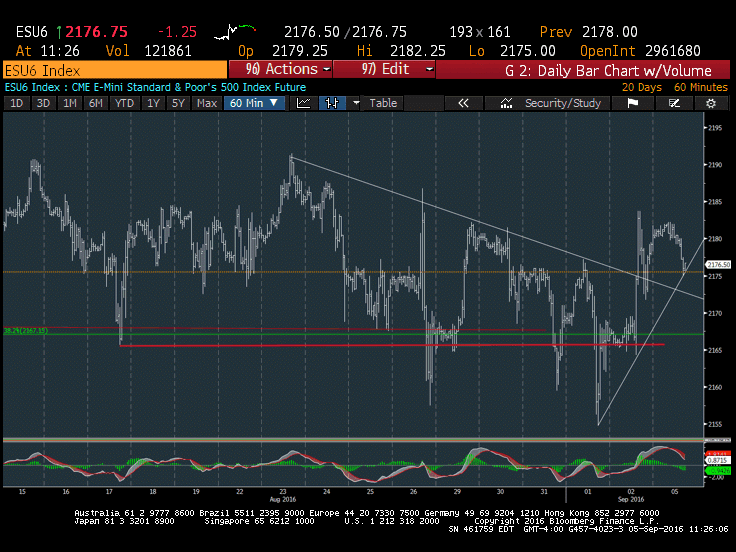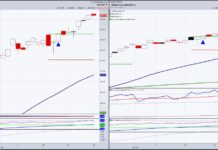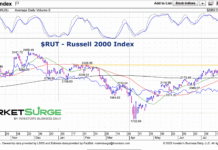The resilience of the S&P 500 Index (INDEXSP:.INX) last Friday following a less than stellar Jobs report is seen as a real technical positive. It allowed the index to eclipse a minor downtrend and rise to new multi-day closing highs.
Additional strength looks likely in the days ahead.
Below are some key technical takeaways and my short to intermediate term outlook for S&P 500 futures and the broader equities market.
US Equity trading range ongoing; Rally continues to be selective, but last Friday’s close argues for additional upside near-term. If this sideways pattern since mid-July has taught market participants anything, it’s to expect the unexpected. We’ve had at least 3-4 breakout attempts over the last couple months which have failed. Equities along with Treasury yields, continue to be range-bound, though with a decidedly upward bias since late June. These types of trading ranges following large upswings rarely prove to be topping patterns, and traditionally tend to follow-through in the direction of the original move. Given a lack of counter-trend exhaustion on numerous timeframes for SPX along with Advance/Decline still within striking distance of highs, it doesn’t seem like a trend reversal is all that imminent. The dropoff in breadth since early July is not unlike what happened back in March-April after the initial spike from mid-February and isn’t necessarily bearish. For now, it should pay to stay long and anticipate a move over 2200, though potentially with limited upside to 2215-2220, or 2250 maximum.
Sector-wise, the dropoff in Healthcare and Consumer Discretionary are somewhat concerning, and if Clinton’s gap on the Presidency widens, this very well might continue to pressure Healthcare. For now there’s only so much that Financials and Technology can carry the market, and there is some evidence of a bit more selectivity in stocks, despite the Advance/Decline near all-time highs. For now, this ongoing sector rotation seems to continue to bail the market out, and really no signs are there that this will change, regardless that the market has entered September.
The rotation out of Defensives looks to be nearly complete now, which was written about over the last couple weeks. Specifically, the positive momentum divergence seen in Utilities over and in Telecomm recently is encouraging for these sectors after backing off to near key support. Much will depend on Treasury yields NOT breaking out though to argue that these should work, and over 1.63% for example, on TNX, would be likely quite negative for both sectors. Additionally, a move up towards 2200 and above would likely also not be led by the Defensives, so this needs to be taken into consideration. For now, these sectors seem to be stabilizing after dropping off from June, so rallies should happen in the next 30-60 days, which would coincide well with potential negative US stock seasonality.
The US Dollar’s rip and reaction post Jobs report last Friday was telling, and despite all the weak economic data, the Dollar still finished quite strong while Treasury yields closed well up off the lows, in a rapid roller-coaster style reversal for both. Quite a few came out to bolster the case for rates to go higher, and some of this was based purely on the stock market’s resilience, i.e. “Dow Dependency” vs “Data Dependency”, which can’t really be ruled out these days (If the Fed has a “window” where the market has held up amidst Election uncertainty or otherwise, it very well might choose to hike, if the market comes to expect it) Last Friday saw a huge swing in Fed Fund Futures incorporating all this data and by end of day, the chances stood at 32%, up from the low 20’s. If this continues to move to 50 on lack of a market correction ahead of the Equinox FOMC meeting, and/or various other Economic data come in strong, one can’t be surprised that the Fed very well might hike, which would cause further spikes in Yields, and the US Dollar index, and be negative for Commodities, but also for these Yield centric sectors which have been stabilizing. We’ll see.
S&P 500 Futures Trading Chart
SHORT-TERM/ INTERMEDIATE-TERM TECHNICAL THOUGHTS ON SPX DIRECTION
Short-term Thoughts (3-5 days): Bullish – As stated above, it remains difficult to have a real bearish stance on stocks given Advance/Decline data being strong and ongoing trading ranges for SPX and others after the late June surge, while sentiment remains largely skeptical. The latest data came in with More bears than Bulls for AAII, and while just one datapoint Sentiment-wise, it’s certainly important to not exclude this in making an opinion. Overall, as has been said here in the past, a move up to 2200 and over towards 2210-2215 remain legitimate upside targets to consider possible before any larger top appears. Use any early week decline under 2157 to buy at 2141 with thoughts that a snapback to 2200 and above should occur.
Intermediate-term Thoughts (2-3 months): Bearish – No change in thinking here, and despite the short-term view being inconclusive and largely still positive on move back to new highs, i still view a selloff to be a possibility in the latter half of September into October. The combination of the divergences in indices hitting new highs the uptick in bullish sentiment along with markets entering a notoriously bearish time seasonally makes it likely that any pullback over the final five months of the year likely takes place in August-October. While momentum and breadth remain quite positive, most of the argument for fading stocks at this time is more of a counter-trend argument, which hasn’t yet materialized in the form of index weakness. However, Most cycles along with Demark indicators highlight the possibility of a stalling out/reversal in August. Given the fact that indices have moved higher into this period argues that the upcoming turn should be a reversal from market highs, not lows. Additionally, another intermediate-term concern which should be mentioned is the degree of deterioration in momentum which began last year into August lows. Even a rally back to new high territory won’t allow momentum to get anywhere near where it was back in late 2014/early 2015 and this is a 12-18 month concern. For now, for this time frame, additional intermediate-term strength still looks possible into mid-August, with key targets at 2180-5 and then 2250.
Thanks for reading.
Twitter: @MarkNewtonCMT
Any opinions expressed herein are solely those of the author, and do not in any way represent the views or opinions of any other person or entity.









